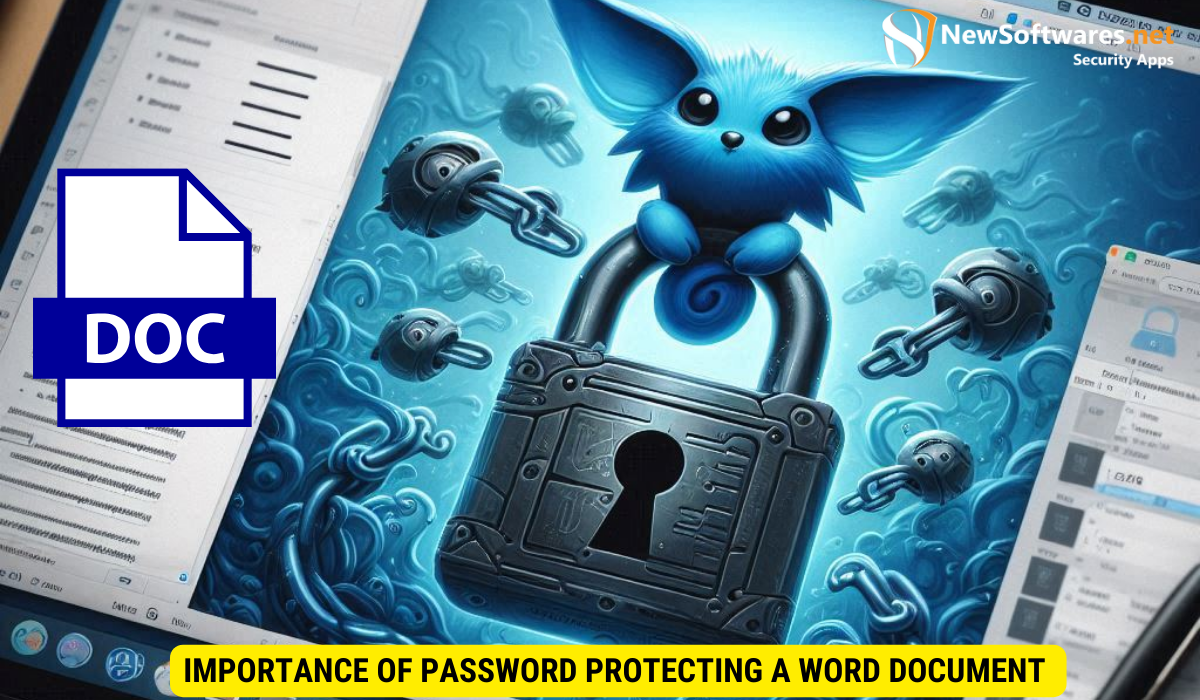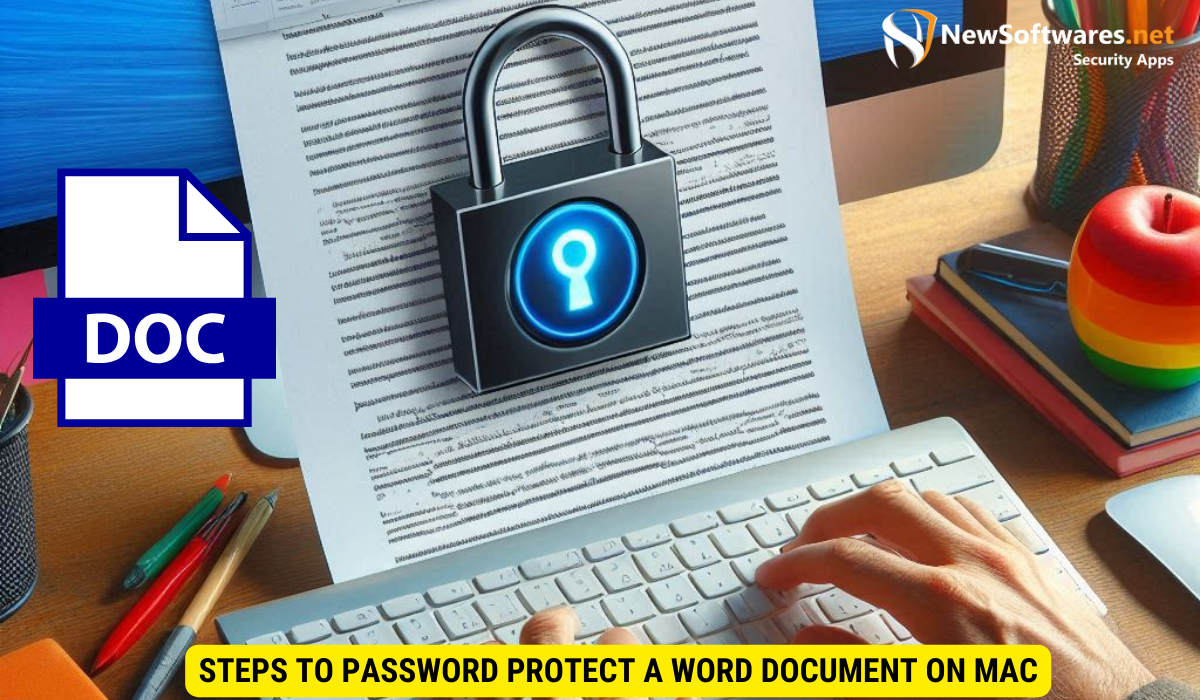To password protect a Word document on Mac, follow these steps:
- Open the Word document you want to protect.
- Go to File > Info > Protect Document.
- Click on Encrypt with Password.
- Enter your desired password and confirm it.
- Save the document to apply the password protection.
In today’s digital world, protecting your sensitive information is of utmost importance. Whether it’s personal or professional documents, you want to ensure that only authorized individuals have access to them. One effective way to achieve this is by password protecting your Word documents on a Mac. I will guide you through the steps to password protect your Word documents and provide you with essential tips to create a strong password.
Importance of Password Protecting a Word Document

Before diving into the steps, it’s crucial to understand why password protection is essential. Password protection plays a pivotal role in data security. It acts as the first line of defense against unauthorized access to your Word documents, ensuring that only those with the correct password can view or modify the content.
The Role of Password Protection in Data Security
Password protection adds a layer of security by encrypting your Word documents. It prevents intruders from gaining unauthorized access and protects your sensitive information from being exposed. In the event of a security breach, password protected documents act as a safeguard, maintaining the confidentiality of your data.
Why Password Protect Your Word Documents?
There are numerous reasons why you should consider password protecting your Word documents. Perhaps you have a confidential report containing financial data, private notes, or sensitive client information. By password protecting these documents, you can ensure that only authorized individuals have access to them, mitigating the risk of data leaks or unauthorized modifications.
Moreover, password protection is not limited to just Word documents. It is a best practice across various platforms and applications, including email accounts, online banking, and social media profiles. By using strong, unique passwords and enabling two-factor authentication where possible, you can significantly enhance the security of your digital assets.
Enhancing Data Privacy with Password Protection
Another aspect to consider is the importance of data privacy in today’s interconnected world. With the increasing prevalence of cyber threats and data breaches, safeguarding your information is more critical than ever. Password protection serves as a proactive measure to secure your sensitive data and maintain control over who can access it.
Preliminary Steps Before Password Protection
Before we dive into the process of password protecting your Word documents, let’s go through a couple of preliminary steps to ensure a smooth experience.
Ensuring the security of your sensitive information is paramount in today’s digital age. By taking the time to implement password protection on your Word documents, you are adding an extra layer of defense against unauthorized access and potential data breaches.
Checking Your Word Version Compatibility
To begin, it’s important to ensure that your version of Microsoft Word on your Mac supports password protection. Older versions may not have this feature, so it’s recommended to update to the latest version to take advantage of enhanced security measures.
Microsoft regularly releases updates and patches to address security vulnerabilities and improve the overall functionality of their software. By keeping your Word application up to date, you not only gain access to the latest features but also ensure that your documents are better protected against potential cyber threats.
Backing Up Your Word Document
It’s always a good idea to create a backup of your Word document before applying any changes, including password protection. This will provide you with a safety net in case you encounter any issues during the process or accidentally forget the password.
Backing up your files is a best practice that can save you from the frustration of losing important data. Whether it’s through cloud storage services, external hard drives, or even traditional methods like printing hard copies, having a backup ensures that your information remains accessible even in the face of unexpected events like hardware failures or ransomware attacks.
Steps to Password Protect a Word Document on Mac

Now that you’ve completed the preliminary steps, let’s proceed with the process of password protecting your Word documents on a Mac.
Before diving into the steps of password protection, it’s important to understand the significance of securing your sensitive documents. By adding a password to your Word document, you can prevent unauthorized access and safeguard the confidentiality of your information. This extra layer of security ensures that only individuals with the correct password can view or edit the content, adding peace of mind to your digital workspace.
Opening the Document You Want to Protect
To begin, open the Word document that you wish to password protect. Navigate to the “File” tab at the top of the screen and click on it to access the drop-down menu.
Locating the document you intend to protect is the first step towards enhancing its security. Whether it’s a confidential report, a personal journal, or a critical business proposal, applying a password will fortify its defenses against unauthorized access.
Navigating to the ‘Protect Document’ Option
In the “File” tab drop-down menu, scroll down and locate the “Protect Document” option. Click on it to reveal additional security options.
By selecting the “Protect Document” option, you are taking proactive measures to safeguard your information. This feature empowers you to control who can view and modify the contents of your Word document, ensuring that your data remains secure and confidential.
Setting Up Your Password
Within the “Protect Document” options, click on “Encrypt with Password.” A dialog box will appear, prompting you to enter a password of your choice. Ensure that you create a strong password that is unique and difficult to guess.
Choosing a robust password is crucial in maintaining the integrity of your document’s security. Consider using a combination of uppercase and lowercase letters, numbers, and special characters to enhance the complexity of your password. Remember, the strength of your password directly impacts the level of protection it provides.
Once you have entered the password, click “OK” to apply the password protection to your Word document.
After setting up the password, it’s recommended to save your document to ensure that the password protection is in effect. Remember to store your password in a secure location or utilize a trusted password manager to prevent any potential loss of access to your protected document.
Tips for Creating a Strong Password
A strong password is essential for protecting your Word documents effectively. Here are a few tips to help you create a robust password:
Creating a strong password is crucial in safeguarding your personal and sensitive information online. A strong password acts as a barrier against unauthorized access and potential cyber threats. By following best practices in password creation, you can significantly enhance the security of your accounts and data.
The Characteristics of a Strong Password
A strong password should consist of a combination of uppercase and lowercase letters, numbers, and special characters. It should be at least eight characters long and avoid common words or easily guessable information, such as birthdays or pet names.
Moreover, consider using passphrases instead of passwords. Passphrases are longer combinations of words that are easier to remember but harder to crack. For example, “PurpleElephant$789Rainbow” is a strong passphrase that combines randomness with personal relevance, making it both secure and memorable.
Tools to Generate and Store Secure Passwords
If you struggle to come up with a strong password, you can use password generation tools available online. These tools can create complex and unique passwords for each of your accounts, reducing the risk of password reuse across multiple platforms.
Furthermore, consider utilizing reputable password managers to store and organize your passwords securely. Password managers encrypt your login information and provide an extra layer of protection against potential data breaches. By centralizing your passwords in a secure vault, you can access them conveniently while maintaining robust security practices.
How to Unlock a Password Protected Word Document
If you need to access a password protected Word document, follow these steps:
Opening the Document with the Password
Open the Word document that is password protected. When prompted, enter the password that you used for protection. Once the correct password is entered, you will gain access to the content.
Removing the Password Protection
If you no longer require password protection for a particular Word document, you can remove it by following these steps. Navigate to the “File” tab, click on “Protect Document,” and select “Encrypt with Password.” Delete the existing password and click “OK” to remove the password protection.
Key Takeaways
- Password protection is crucial for safeguarding your sensitive information and preventing unauthorized access.
- Backing up your Word document is essential before implementing password protection.
- Create a strong password by combining uppercase and lowercase letters, numbers, and special characters. Avoid common words or easily guessable information.
- If you want to remove password protection, navigate to “Protect Document” in the “File” tab, delete the existing password, and click “OK.”
- Consider using password management tools to generate and securely store your passwords.
FAQs
Can I remove password protection from a Word document if I forget the password?
No, if you forget the password to a password-protected Word document, you cannot remove the password or access the document. Microsoft Word uses strong encryption to ensure the security of password-protected documents, making it virtually impossible to remove the password without it.
What happens if I forget the password to a password protected Word document?
If you forget the password to a password-protected Word document, you will not be able to open or edit the document. There are no built-in recovery options in Microsoft Word, so it’s essential to remember your password or store it securely.
Is it necessary to update to the latest version of Microsoft Word for password protection features?
Yes, it is recommended to update to the latest version of Microsoft Word to ensure you have the most up-to-date security features. Newer versions of Word may offer enhanced encryption and additional security measures to protect your documents.
What are the risks of using a weak password for password protection?
Using a weak password for password protection can leave your document vulnerable to unauthorized access. Weak passwords can be easily guessed or cracked by attackers using brute force methods. It’s crucial to use strong, complex passwords to ensure the security of your documents.
Are there any alternatives to password protection for Word documents on a Mac?
Yes, there are alternatives to password protection for Word documents on a Mac. You can use disk encryption tools like FileVault to encrypt your entire disk, ensuring that all your files, including Word documents, are protected. Additionally, you can use third-party encryption software to add an extra layer of security to your documents.
Conclusion
Password protecting your Word documents on a Mac is a simple yet effective way to enhance data security. By taking the necessary steps and setting up a strong password, you can ensure that only authorized individuals can access your sensitive documents. Remember to periodically review and update your passwords to stay one step ahead of any potential security threats.
